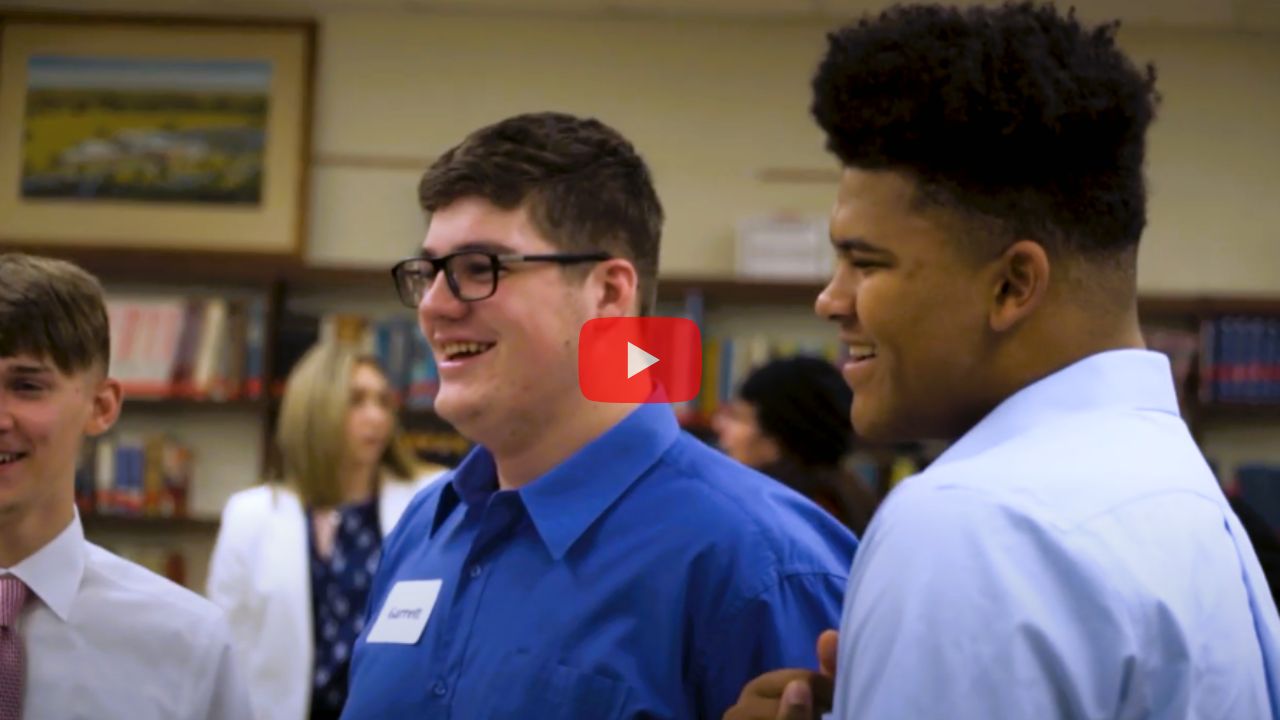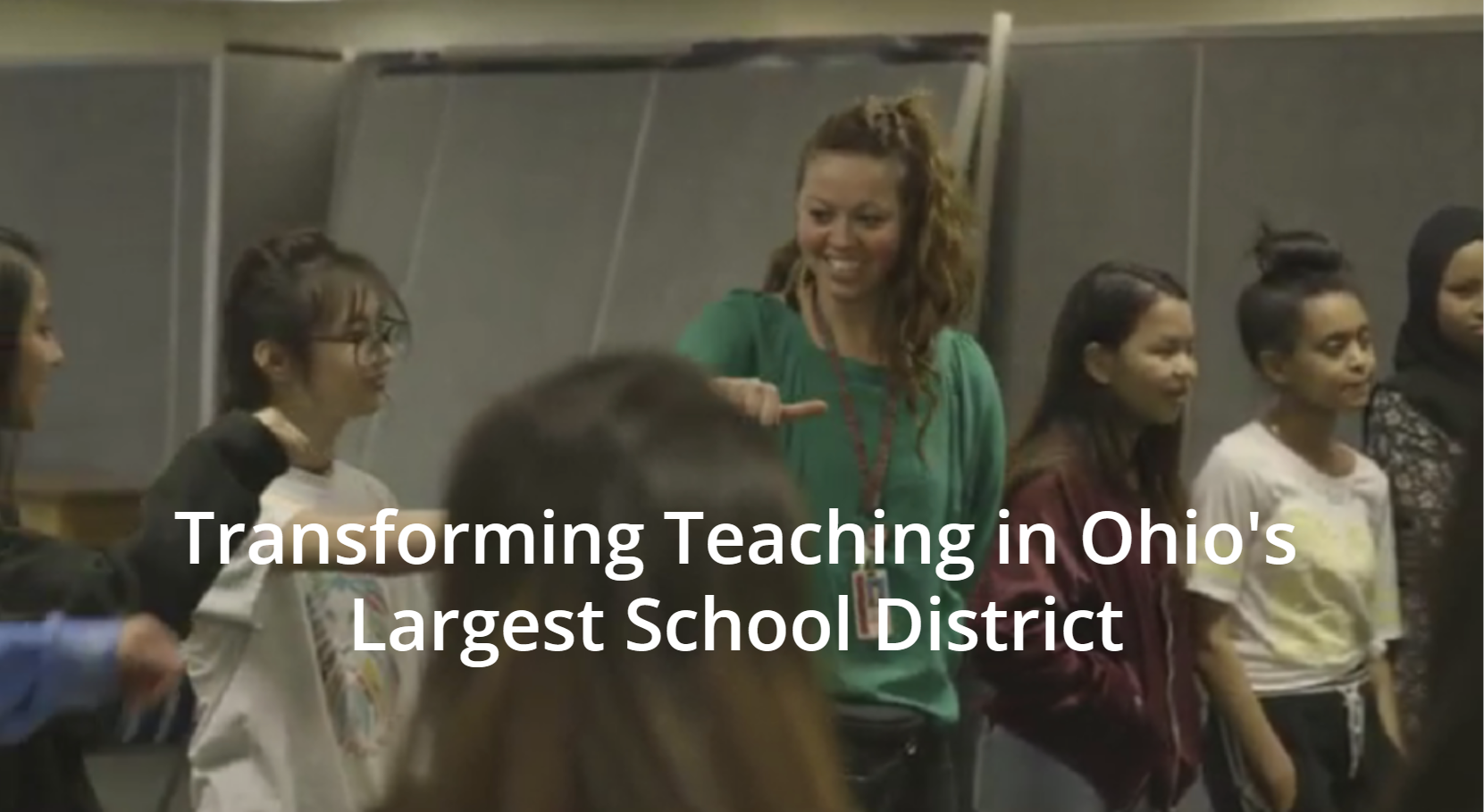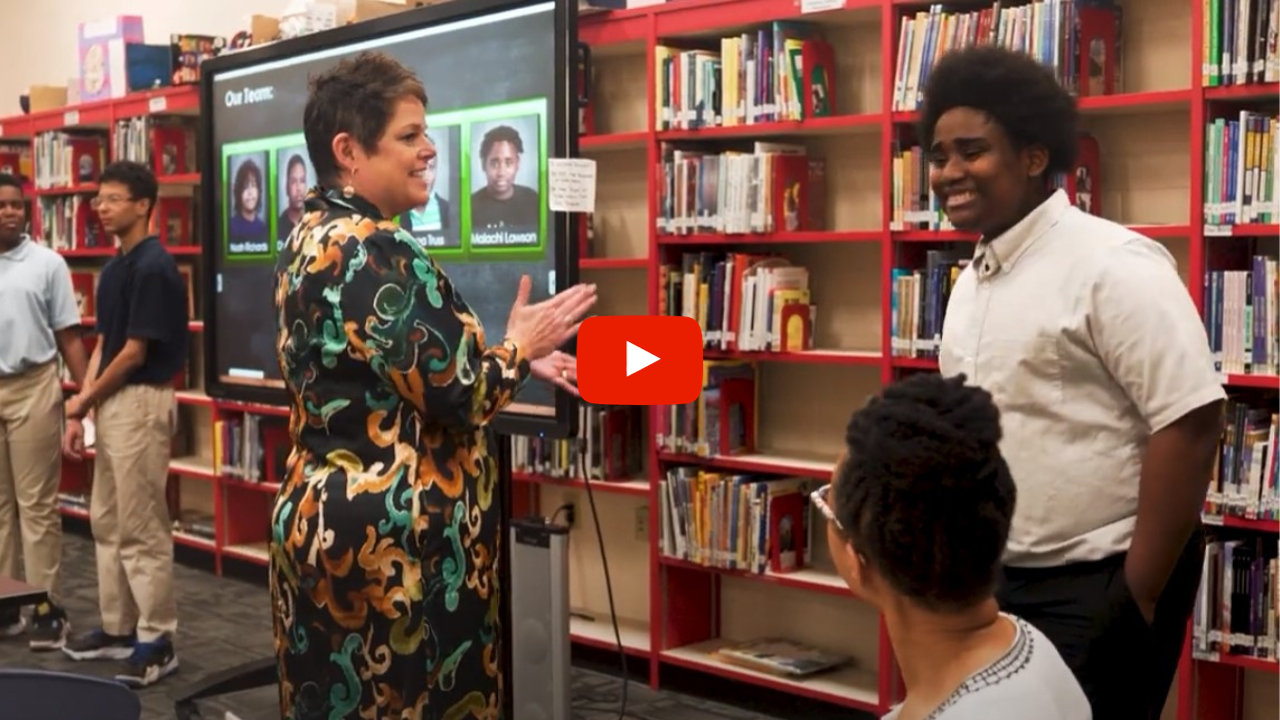In this episode, Doris explains the process for building a program and how it can be grown in many different ways outside of a traditional classroom setting. She explains the role of piloting educational innovations and the importance of identifying which resources you have and which ones you need.
Alison: So we’ve been talking a lot about the entrepreneurship course specifically that we’re in the midst of, here at this school, but I know you’ve developed a number of programs and have trained a number of educators to generate their own programs and develop them further. I’m just curious, where do you start with that process, where does that begin?
Doris: Yeah, that’s a good question, because you’re learning this thing, but I think that what’s always important, it’s like anything else you do. So you start with okay, what are your objectives and what are your starting ingredients, right? So maybe you’re a middle school science teacher at a public school. You say, well, I have 35 7th graders in each class and 40 8th graders in each 8th grade class, and my job is to teach them 7th and 8th grade science. We don’t have a lot of resources, they don’t all have technology.
Here’s the kind of span of backgrounds they might have. This is what I’m trying to get them to learn. We talk about that, what do you hope they most get out of what commit . . . blah, blah, blah. You really start with, like anything, what really are the major objectives.
Not a laundry list of 58 topics, but what are those major things, major skills, key concepts, knowledge sets, that you really hope that if nothing else they end the year really getting in a great way. What are your ingredients? What do we have in front of us?
I’ve worked with people who aren’t in a school, who do summer camps. I’ve worked with people who have accelerator programs, who aren’t even in . . . I mean, it is education, but, you know.
So you have to look at what you . . . how much, what kind of time do you have with them. Are they required to take this class or have they chosen it. You have to kind of look at what are the ingredients, what’s the setup.
Then I talk about what I think are the operating philosophies that matter most, the most important ones. Talk about these things like they have to work on something that they find meaningful, that it’s meaningful to them.
There are a lot of different ways to get at that. There isn’t a one-size-fits-all answer to that. It isn’t always go find a business that has a real problem. There are lots of ways to do it.
You can teach Chinese history and still have the conversation start when you’re creating the curriculum. If we want them to learn about the Ming dynasty, how can we structure this so that those students who are in this course because it’s a requirement, and 10% of them are going to be just naturally fascinated by the Ming dynasty and 90% of them are just going to want to suffer through it. How do you change that so that they’re all crazily interested in learning about the Ming dynasty?
It has to start, has to start with a conversation about how can we do this in a way that they’re working on something that’s meaningful to them. That’s where a lot of the hard thinking initially comes in. That’s the number one big thing in terms of the how. And the second equally big thing about the how is what you as an educator can do and want to do most readily.
So start with who you are and what you’ve got, how do you get those two things together, given those learning objectives, given the ingredients you have, how do we use what you’ve got and you do best and want to do, what you are and what you’ve got, to create something, some way, for them all to be engaging in something that’s really, really meaningful. They want to do it, that will . . . and then how do we set that up in such a way that they can’t possibly help but learn the things you want them to learn about the Ming dynasty. How do we set that up?
Then, always, multiple times in that conversation, I will say the following things. I’m the Queen of Piloting. Find a way . . . you’ve heard me . . . is there a way for you to try this in a low stakes, low profile kind of way?
So you’re already teaching a 9th grade history course or a 9th grade humanities course. Instead of deciding okay, I’m going to create a whole new course that’s going to be completely like this next year, can we do that the year after and have you pilot something next year, like a three-week China unit.
Or if you’re the 7th grade science teacher at the public school, can you do one unit in one of your classes, maybe just for the seventh graders or just for the 8th graders. Just one unit, low stakes.
We do it entirely differently like this. Let’s just work on one little thing and don’t trumpet, don’t come out with a big launch or tell people about it. Just try it, experience it once. Give yourself room to experiment, to try it, to go ooh, that didn’t work so well. We’re not saving lives here, your 7th graders will survive their life and even their middle school.
What’s the worst thing that happens? The four-week unit that you do is kind of a meh. You think students have ever gone through a four-week science unit in 7th grade that isn’t so hot? I bet they have. So try it.
I always talk about rules of three. Anybody who’s taught for a while, I say this and they nod their head, “Oh yeah.” It’s always the third time you teach something new, it’s that third time that you, for the first time, feel like okay, I’ve got this now.
So give yourself a first, a pilot. Find a way. I can’t tell you the number of teachers I work with . . . I’m not just saying this . . . who come in and they’ve already decided with their school, that before they’ve even come to see our workshop, they have no entrepreneurship program or, but next year they’re going to have this entire class, all year, for juniors, that’s an entrepreneurship class. They come in and they say “Okay, it’s the end of the summer, we’ve got our sign-ups, we’re going to start next fall, and I say there’s got to be a way for you to do, to . . .
Alison: Scale it back.
Doris: “. . . can you scale it back? Can you instead do that the year after once you know okay, I’ve got it. I know what I’m doing? Is there any way? Do a club, do an elective that’s a three-week thing?”
I’ve had this conversation I just remembered with a couple, an administrator and a teacher from a school who came in already having sold to their board this program. Actually we ended up changing it.
So they went back and said they were told . . . I said tell them, lie, and tell them you met this woman who’s an expert . . . don’t tell them my name because then they’ll know I’m not . . . and she said absolutely should not do that, and you have to do it the year after. You can use me however you want. And I said okay, I asked a bunch of questions and where we came up with, I said okay, that’s it, senior project.
Have a senior project or an independent study where you try this out next year. Then the year after, do it, whatever. They changed it. So does that answer your . . . ?
Alison: Absolutely. I think it’s a really great takeaway that often people can be intimidated by the thought of, “Oh my gosh, how am I ever going to. . . ?” Maybe I don’t have a background in the specific content area or I have no idea how to approach teaching in this way, I have to shift my mindset entirely.
To know that if you’re going to launch anything, you have to start somewhere. And that the sooner you start and have opportunity to fail a little bit . . . like we tell our students . . . iterate some more, figure out the sweet spots, that once you grow it to a sizable course or program, whatever it ends up being, that it’s built on some strength.
Doris: Yeah, yeah, exactly. And also, what’s interesting is there are a lot of hows, there are a lot of specifics. Try this, do this, here’s the way we did this, here’s some assignments, here’s a workshop, here . . . there’s all kinds of things. Depending on what you’re teaching and how you’re teaching and what kind of problem they’re solving, there’s a lot of different things to say.
One of the things that at a kind of higher level, this will sound really obvious, but it actually isn’t, I find, the way a lot of what we do is approached. So I didn’t word it that well, but you know what I’m saying.
Alison: Sure.
Doris: So I’ve been in schools for, I guess this is my 19th year. And so much of our conversation as teachers is about I’m going to teach this or we’re both teaching the same course, what are we going to teach, what should we choose, out of all these different things, let’s do this instead, let’s do that, maybe we should take out this unit and instead do that unit, whatever it is. I remember seeing this really early, and then just seeing it over and over again.
So a handful of teachers sitting in a room, a faculty lounge. Student walks in who’s like a senior and asks something of one of the teachers. There’s a little conversation, and in the conversation, the student says something like, “Oh, yeah, I’ve actually never heard of the French Revolution, we never learned that.” I’m making this up . . . but, “I’ve never heard it, we never learned the French, I was never taught that, and so that’s why I don’t know.” The teacher goes on and they have a conversation and the student leaves.
Then the rest of the teachers are oh my gosh, that’s crazy, that’s crazy. Then one of the teachers sitting there says, “That’s not true. So I know what class that student took in junior year, and they actually did cover the French Revolution. That’s not true, da-da-da.” So there’s this whole discussion.
How many things these students, we spend all this energy, the schools, talking about the curriculum and what topics we cover and what we’re testing them on and blah, blah, blah. Then we’re shocked to find that actually crazy, crazy percentages of what we’ve covered never stuck. And so then . . . right?
Alison: Yeah.
Doris: So if you’re talking about what should we teach in the 9th grade humanities course during the China unit, what should we teach? How long is the unit? Well, we always spend three weeks on China in the humanities in that course. And is that for all of our students, most of what they’re going to get from us about China in high school? Maybe it is. I’m making this up. . .
So we could sit here and spend a whole lot of time arguing about which particular texts and which particular topics we think are most important if we only have three weeks with 14-year-olds to teach them about China in the 45 minutes every day that we have them. At the end of the day, what does that kid come out of there with?
So here’s the difference. If what you care most about is not what specific items you choose to teach, but what did they learn about in this three-week unit?
You say well, what I really hope they learn, because they’re not going to learn all of Chinese history or even a smidge of it in three weeks. What I hope they learn coming out is they learn enough about China to have an appreciation for the culture and the history and the orientation, and that they’ve actually discovered that it’s interesting to them. If they do, enough of that, and by the way, here are some basic things I think they need to know. I think they need to know this much about the Ming dynasty and they need to have familiarity with this and this and that.
If you construct that three weeks with what I talked about earlier, what do I have bringing to the table as a teacher than I can really, really sink my teeth into and do well. How do I structure this three-week unit so that they’re working on something they themselves find really meaningful, wow, you’re going to be thrilled with what happens in only three weeks in terms of bad students learning about Chinese history, and it’s lasting, right?
Alison: Hopefully so. Think about experiential learning and putting students in that process with problem solving, about things that are meaningful to them, putting it in a much different light. Absolutely, it shifts everything to the point that they come out stronger and more confident and well knowing.
Doris: How you set it up when it comes . . . there’s a zillion different ways to do it. We all want to find sort of the single formula, the magic secret formula. It doesn’t work like that, right?
This idea that there are absolute and that it must be experiential and it must be this and it must have these attributes or it’s not good. Skills matter, content doesn’t, never lecture, never do . . . like the minute you decide that there are these do’s and don’ts that always happen, all we’re going to do is we’re now going to develop another model that ten years from now also doesn’t work. So there aren’t easy answers to these things.
By the way, talk about design, this is about good design. When you are designing a learning experience, whether you’re designing a product, you’re designing a learning experience, you’re designing a service, you’re designing a whatever, what do you have to start with? You have to start with understanding what the meat is, really, really understanding it.
Alison: Absolutely.
Doris: What you have, in that what is it that I can do that satisfies that need, given what I’ve got, and who I’m working with. So you’ve got to understand your audience, you have to understand the need, and you have to be very realistic about what you have and can do.
Building great curriculum is no different. For me it’s, you have to always be thinking not about what am I going to teach them, but what do I want them to learn. What do I want them to learn?
Saying I want them to learn this, this, this, this, and that about the Ming dynasty, and therefore if I just tell them, they’ll learn it, we have ample evidence that that isn’t effective.







